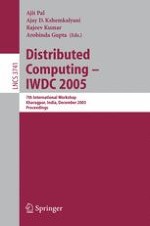2005 | Book
Distributed Computing – IWDC 2005
7th International Workshop, Kharagpur, India, December 27-30, 2005. Proceedings
Editors: Ajit Pal, Ajay D. Kshemkalyani, Rajeev Kumar, Arobinda Gupta
Publisher: Springer Berlin Heidelberg
Book Series : Lecture Notes in Computer Science
